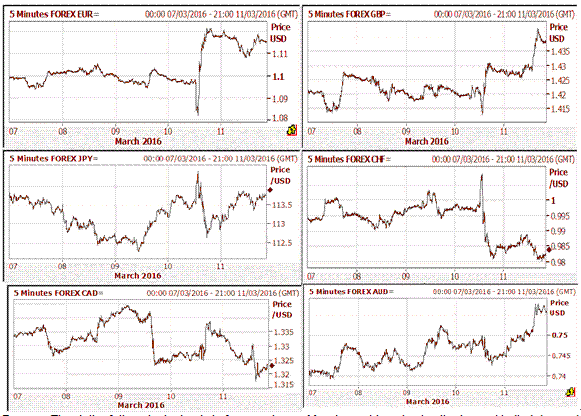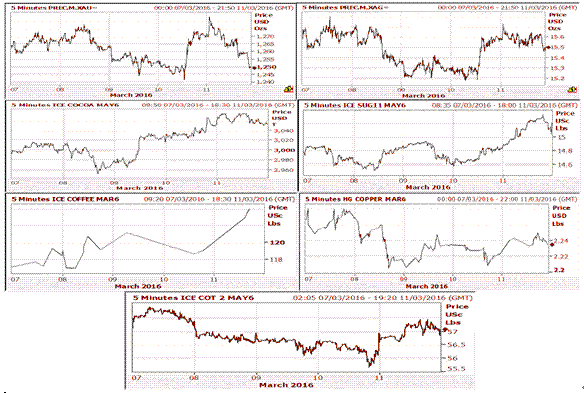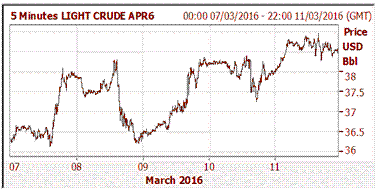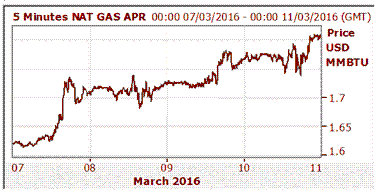FOREX
Forex – The dollar fell against a basket of currencies on Monday as big gains in oil prices rekindled demand for the euro and commodity-sensitive currencies, soothing concerns about the effects of weak commodity prices on the global economy. A rally in industrial metal markets led by a 20 percent surge in iron ore prices also stoked bids for riskier currencies and reduced the allure of the greenback. The increase in oil and metal prices followed assurances from China this weekend that its economy is not heading for a hard landing. The greenback rose earlier on Monday on the euro's weakness and a reassessment by traders of Friday's jobs report, which showed stronger-than-forecast hiring in February but a surprise dip in average hourly earnings.
The euro held firm on Wednesday in choppy trading as investors awaited a European Central Bank meeting, which they expect will result in interest rates falling deeper into negative territory and more bond purchases to help the euro zone economy. The Canadian dollar jumped after the Bank of Canada left policy rates unchanged and said its economic outlook was largely the same as January as recent market volatility "appears to be abating." A rebound in oil and metal prices also rekindled bids for the Canadian dollar and other commodity-sensitive currencies including the Australian and New Zealand dollars.
The euro dipped on Friday after a shocking series of moves around Thursday’s European Central Bank meeting which ended with its biggest gain in a month, undermining the case of those still calling for a fall to parity with the dollar. The bank took a series of bold easing steps, including an expansion in asset buying and a deeper cut to already negative deposit rates that added up to far more than the market had expected and should have weakened the single currency. But ECB President Mario Draghi's comment that he expected the bank might not have to cut rates further fed concerns that officials in Europe and Japan are running out of ammunition with which to weaken their currencies and raise inflation.
INDICES
Indices - European shares fell on Monday, unable to maintain the momentum that took Asian equities to two-month highs, as investors said a rebound in stocks seemed tired and looked ahead to a European Central Bank meeting expected to deliver more stimulus. U.S. shares were also expected to open lower, with futures suggesting they would open down 0.4-0.6 percent. The euro tumbled against the dollar before Thursday's ECB meeting at which policymakers are expected to cut interest rates further into negative territory. Sentiment in commodity markets was buoyant, however, with oil powering ahead and iron ore surging on expectations Chinese steel mills will implement short-term output cuts.
Oil prices resumed a month-long rally on Wednesday, helping to lift world stock markets, while bond prices weakened ahead of this week's European Central Bank meeting. U.S. stocks were moderately higher, with gains in the S&P 500 led by a 1.7 percent jump in the S&P energy. The Dow Jones industrial average rose 0.15 percent. The S&P 500 gained 0.4 percent and the Nasdaq Composite added 0.43 percent. The biggest weekly draw in U.S. gasoline in almost two years persuaded traders that energy demand was improving despite crude stockpiles at record highs. The U.S. Energy Information Administration said stockpiles USOILC=ECI rose 3.9 million barrels to nearly 522 million barrels, as predicted by analysts in a Reuters poll.
The euro steadied and European shares and bonds rebounded on Friday after being savaged on Thursday when the European Central Bank signalled it was unlikely to cut its negative interest rates further in the wake of a huge new stimulus plan. Markets were starting to focus on what they saw as the positive features of the ECB policy package, with surges to 2016 highs for both U.S. oil prices and China's Yuan also boosting confidence. Wall Street was expected to open around 1 percent higher while Europe's FTSEurofirst 300 jumped 2.3 percent as German shares enjoyed their best day of the year; Italian markets surged over 4 percent.
COMMODITIES
Commodities - Gold rose on Monday, hovering just below last week's 13-month high as the U.S. dollar turned lower, while a fall in average U.S. earnings lessened expectations the Federal Reserve could raise interest rates at its next policy meeting. Spot gold was up 0.6 percent an ounce by 3:12 p.m. EST (20:12 GMT). Gold fell on Wednesday as oil prices and world stock markets rose, and expectations for further monetary easing from the European Central Bank prompted some investors to take profits after the metal's rally to 13-month highs last week. Outflows were seen from bullion-based exchange-traded funds after hefty inflows earlier in the year. Gold fell 1 percent on Friday, as the dollar rebounded and oil and world stock markets rose, after bullion extended the prior session's gains to a 13-month high touched in early trade after the European Central Bank's announcement of additional easing. ECB President Mario Draghi rolled out measures on Thursday including increased asset buying and a deeper cut to deposit rates, but signalled there would be no further rate cuts.
London cocoa futures on ICE rose to a two-month high before paring gains on Monday, as rain in top grower Ivory Coast boosted hopes for improved crop output and the rising British pound provided a source of pressure. Sugar turned lower, falling away from the prior session's six-week high, and coffee dropped, with both markets feeling pressure from a softer Brazilian currency, which attracts producer and speculative selling. Cocoa futures on ICE rose to the highest in more than two months on Wednesday, supported by concern that the West African mid-crop could be significantly smaller than last year's, while sugar prices extended gains to the highest in 2016 so far. Coffee futures rose to multi-week highs. Cocoa dealers said there remained considerable uncertainty over the crop outlook, with recent rains possibly providing some relief after prospects were damaged by an earlier prolonged spell of hot, dry weather. Sugar on ICE jumped 3.5 percent to the highest level in more than two months on Friday, buoyed by expectations for tight supplies and on chart-based buying, while short covering helped lift coffee futures to a five-week peak. Cocoa turned quietly lower after rising to the highest prices in more than two months, with the London market closing higher for the fifth straight week.
Henyep Investment (UK) Ltd is a company of the Henyep Financial Group and is authorised and regulated by the Financial Conduct Authority (FCA).
ENERGY
Crude Oil - Global oil markets jumped more than 5 percent on Monday, after Ecuador said it was holding a meeting of Latin American crude producers as OPEC sought a higher anchor price for oil. Technically-driven buying in crude and a commodities rally also boosted oil. Industry data showing a smaller than expected build in stockpiles at the Cushing, Oklahoma delivery hub for U.S. crude futures was another supportive factor.
Crude prices rose as much as 5 percent on Wednesday, with U.S. crude hitting three-month highs after a big gasoline inventory drawdown amid improving demand overshadowed growing record high crude stockpiles.
The U.S. Energy Information Administration said crude stockpiles rose 3.9 million barrels last week to reach nearly 522 million barrels, in its fourth week of building to record highs.
Oil rose up to 2 percent on Friday, with U.S. crude gaining for a fourth straight week, after the world's energy watchdog said the market may have hit bottom, although Goldman Sachs said the 50 percent rally in under two months was "premature." The Paris-based International Energy Agency, which coordinates energy policies of industrialized nations, said U.S. and non-OPEC crude output was beginning to fall quickly, while increases in Iranian supply had been less than dramatic. The IEA said it believed non-OPEC output will fall by 750,000 barrels per day this year, some 25 percent more than the 600,000 bpd it previously forecast.
Natural Gas – U.S. natural gas futures on Tuesday edged a couple of cents higher for the third day in a row despite forecasts for warmer weather and light heating demand for the rest of March. After falling more than 28 percent over the past five weeks to their lowest level since August 1998, front-month gas futures on the New York Mercantile Exchange were up 1.07 percent per million British thermal units at 9:03 a.m. EST (1403 GMT).
U.S. natural gas futures on Thursday edged higher for a fifth day in a row after the federal government reported a small storage draw despite forecasts for continued warm weather and light heating demand. Front-month gas futures on the New York Mercantile Exchange closed up 2.1 percent per million British thermal units. U.S. Energy Information Administration said utilities pulled 57 billion cubic feet of gas from storage during the week ended March 4.
U.S. natural gas futures edged higher on Friday for the fifth day of a technical short covering rally, despite forecasts for continued spring-like weather and light heating demand. That would be the longest daily winning streak since January and is poised to leave the front-month up about 10 percent this week after it fell nearly 28 percent over the prior five weeks to its lowest since August 1998.
The information set forth herein was obtained from sources which we believe to be reliable, but its accuracy cannot be guaranteed. It is not intended to be an offer, or the solicitation of any offer, to buy or sell the products or instruments referred herein. Any person placing reliance on this commentary to undertake trading does so entirely at their own risk.
Recommended Content
Editors’ Picks
AUD/USD tumbles toward 0.6350 as Middle East war fears mount

AUD/USD has come under intense selling pressure and slides toward 0.6350, as risk-aversion intensifies following the news that Israel retaliated with missile strikes on a site in Iran. Fears of the Israel-Iran strife translating into a wider regional conflict are weighing on the higher-yielding Aussie Dollar.
USD/JPY breaches 154.00 as sell-off intensifies on Israel-Iran escalation

USD/JPY is trading below 154.00 after falling hard on confirmation of reports of an Israeli missile strike on Iran, implying that an open conflict is underway and could only spread into a wider Middle East war. Safe-haven Japanese Yen jumped, helped by BoJ Governor Ueda's comments.
Gold price jumps above $2,400 as MidEast escalation sparks flight to safety

Gold price has caught a fresh bid wave, jumping beyond $2,400 after Israel's retaliatory strikes on Iran sparked a global flight to safety mode and rushed flows into the ultimate safe-haven Gold. Risk assets are taking a big hit, as risk-aversion creeps into Asian trading on Friday.
WTI surges to $85.00 amid Israel-Iran tensions

Western Texas Intermediate, the US crude oil benchmark, is trading around $85.00 on Friday. The black gold gains traction on the day amid the escalating tension between Israel and Iran after a US official confirmed that Israeli missiles had hit a site in Iran.
Dogwifhat price pumps 5% ahead of possible Coinbase effect

Dogwifhat price recorded an uptick on Thursday, going as far as to outperform its peers in the meme coins space. Second only to Bonk Inu, WIF token’s show of strength was not just influenced by Bitcoin price reclaiming above $63,000.




